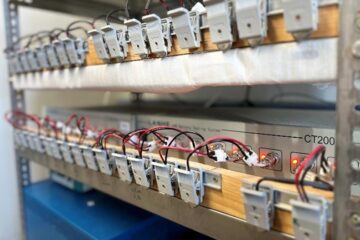Researchers uncover more about how poxviruses evade the immune system

Scientists at Saint Louis University and the University of Alabama at Birmingham have uncovered important new information about a key protein that allows viruses such as smallpox to replicate and wreak havoc on the immune system.
The findings further our understanding of how the pox family of viruses work to subvert the immune system, the researchers say. They also believe their work could one day be used to develop new drugs to combat a variety of inflammatory and immunological disorders, including rheumatoid arthritis and some forms of heart disease.
The research is soon to be published in an early online edition of the Proceedings of the National Academy of Sciences(www.pnas.org).
The paper describes the structure and actions of a powerful substance called interferon-gamma binding protein, which is notorious for the role it plays in helping the poxviruses to replicate. The research explores the interferon-gamma binding protein found in the mousepox virus – one of the family of viruses that also includes smallpox, monkeypox and cowpox.
“Cracking open and describing the structure and actions of interferon-gamma binding protein is incredibly exciting, given the important role this substance plays in subverting the immune system,” said Mark Buller, Ph.D., professor of microbiology and immunology at the Saint Louis University School of Medicine and one of the study’s authors. “This breakthrough is something that many others have tried and failed to achieve.”
Normally when a virus enters the bloodstream, the immune system responds by producing a substance called interferon-gamma, which assists the development of the immune response that’s responsible for ridding the body of the virus.
Poxviruses, however, all come encoded with a potent weapon to evade the immune system: interferon-gamma binding protein. As its name implies, the protein literally binds to interferon-gamma and immobilizes it, preventing it from marshalling the immune system’s defenses. The poxvirus is then able to replicate and cause immense damage.
The research describes how interferon-gamma binding protein looks and behaves on the molecular level during this process, something not previously understood.
“The poxviruses are able to evade the immune system very skillfully,” Buller said, “so we wanted to identify exactly how these viruses work – what makes them so effective and efficient.”
Buller added that the findings have great potential for use in developing drugs that target immunological and inflammatory disorders, including a type of heart disease called atherosclerosis (sometimes referred to as hardening of the arteries), inflammatory bowel diseases (such as Crohn’s disease and ulcerative colitis) and rheumatoid arthritis.
Of all the poxviruses, smallpox in particular has played a gruesome role in human history. The virus is estimated to have caused between 300 million and 500 million deaths in the 20th century alone. Though smallpox was declared officially eradicated in 1979, many experts fear that clandestine samples of the virus may have survived – thus making it a major bioterrorism concern.
“The damage that the smallpox virus has done to mankind is horrific and enormous, which is why we think it’s so important to understand more about the poxviruses and how they operate,” Buller said. “The more knowledge we have, the better we should be able to cope with other major viruses and diseases in the future.”
Buller pointed to co-author Tony Nuara as being critical to the team’s success in understanding more about interferon-gamma binding protein. Nuara, now a fourth-year student at Saint Louis University School of Medicine, was working on his Ph.D. in molecular microbiology when taking part in the research effort.
“Without Tony, this research wouldn’t have happened,” Buller said. “He solved huge numbers of problems and figured out some answers to puzzling questions that previously had no answer.”
(For more information on Nuara and his contribution to the research effort, go to www.slu.edu/x20435.xml).
Mark R. Walter, Ph.D., associate professor of microbiology at the University of Alabama at Birmingham and the paper’s senior author, also noted the efforts of co-authors Sung Il Yoon, Ph.D., Brandi C. Jones, Naomi J. Logsdon and Leigh J. Walter, all of whose work contributed to determining the three-dimensional structure of the binding protein.
“The structure provides a visual blueprint to guide our future studies on interferon-gamma binding protein, which one day may be used to prevent inflammatory disease,” Mark Walter said. “This is clearly a notable achievement.”
Media Contact
All latest news from the category: Life Sciences and Chemistry
Articles and reports from the Life Sciences and chemistry area deal with applied and basic research into modern biology, chemistry and human medicine.
Valuable information can be found on a range of life sciences fields including bacteriology, biochemistry, bionics, bioinformatics, biophysics, biotechnology, genetics, geobotany, human biology, marine biology, microbiology, molecular biology, cellular biology, zoology, bioinorganic chemistry, microchemistry and environmental chemistry.
Newest articles

Rocks with the oldest evidence yet of Earth’s magnetic field
The 3.7 billion-year-old rocks may extend the magnetic field’s age by 200 million years. Geologists at MIT and Oxford University have uncovered ancient rocks in Greenland that bear the oldest…

Decisive breakthrough for battery production
Storing and utilising energy with innovative sulphur-based cathodes. HU research team develops foundations for sustainable battery technology Electric vehicles and portable electronic devices such as laptops and mobile phones are…

Superradiant atoms could push the boundaries of how precisely time can be measured
Superradiant atoms can help us measure time more precisely than ever. In a new study, researchers from the University of Copenhagen present a new method for measuring the time interval,…





















